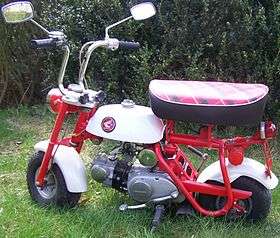Honda Z series
The Honda Z series or Monkey Bike was a line of minibikes made by Honda. Though Honda's official model designations are typically Z50A, Z50J, Z50M, Z50R, and ZB50, they are commonly called the Monkey or Gorilla because small frame's cramped riding posture, suggesting a simian crouch. Sales of the bike began in March 1964 with the Z50M model, and production ended in 2017.

Design
Most Z-series bikes are small, light, collapsible motorcycles made for convenience and ease of transportation. They have 50 cc (3.1 cu in) overhead cam four-stroke engines with an overhead cam. Some have a centrifugal clutch and a three-gear manual transmission, while others have conventional manual clutch and a three- or four-speed gearbox.
The original model of the Honda Z-series was originally produced as a children's ride at a Japanese amusement park, but was eventually refined and put into mass production, hitting the European market in 1967.
Since then, Honda has produced a wide variety of Honda Z-series minibikes, with annual model updates still in effect. Starting from 2008, the well-known 50-cc engine will be adapted and fitted with an injection kit instead of carburetor. Today, cheaper replica versions of this bike are being manufactured in China.
Monkey bike is the name given by Honda to one of their small, low-powered motorcycles introduced in the 1960s. The first Honda Monkey was the 1961 Z100.[1] Later Monkeys were designated Z50, such as the Z50A(US), J, M, R(US) and Z.[2]
These vehicles all had a 4.5-horsepower (3.4 kW), 49-cubic-centimetre (3.0 cu in), single horizontal cylinder, four-stroke engine, and a seat height less than 22 in (560 mm). The first Monkey bikes did not have any suspension, but the front forks were soon added. By 1974, when the Z50J was introduced (US 1972 Z50AK3), suspension had been added to the rear, as well. The first Monkey bikes had 3.5-by-5-inch (89 mm × 127 mm) wheels, but later models had 3.5-by-8-inch (89 mm × 203 mm) wheels.
The early Z series Mini Trails are still highly popular, decades after the end of production, often selling for several times their original price. Refurbishment and upgrade parts are available from a variety of sources and vendors.
The low power of the 49cc engine used in the Mini Trail and Super Cub has resulted in numerous upgrade possibilities, including replacement with larger and newer Honda horizontal engines.
End of production
In March of 2017, Honda Motorcycle president Chiaki Kato announced that the Z50 series would be discontinued in August 2017, due to new and pending emission-control regulations in Japan, which would be very difficult for small-displacement engines to meet. The model would be retired with the release of a limited-run 50th Anniversary Special Edition, which was only available to Japanese consumers. An online lottery, open from July 21 to August 21, was used to select buyers of the 500 units, which sold for ¥432,000 (about $3,900) including consumption tax. This final model of the Z50 mixed aspects of the Z50A (1968) and the Z50AK3 (1972) with a plaid-covered seat duplicating the original Z50M, and most parts were chrome plated.
Similar and derivative designs
Numerous similar small motorcycles predate the Honda model, notably the World War II Welbike motorcycle used by parachutists, and limited numbers of minibikes powered by repurposed lawnmower and chainsaw engines were produced in the 1950s and 1960s. This type of design did not become commonplace or popular until the introduction of the mass-produced Z series.
The Honda Dax model (the ST series in the North American market) is generally not considered a Monkey, but rather a bigger, two-seat variant, with larger 10-inch (250 mm) wheels and usually a larger engine. The Dax models have a monocoque stamped sheet-metal frame, similar to some other early Honda motorcycles. This also houses the fuel tank, battery, and wiring loom.
While Honda has ended production, there are several similar trail bikes being produced in China; some are parts-compatible with original Hondas.
In 2018, Honda introduced the Honda Monkey (as the 2019 model year). While actually based on the Honda Grom, the model name, styling and paint scheme are directly inspired by the early Z series.
See also
References
| Wikimedia Commons has media related to Honda Monkey. |
- Honda Monkey Z100, Honda Motor Co., Ltd, 8 December 2008, archived from the original on 8 October 2007
- Collection Search, Honda Motor Co., Ltd, 2006, archived from the original on 2009-02-04
